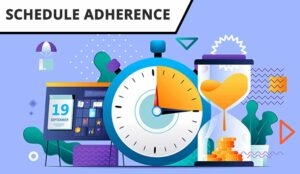In this article Charlie Mitchell explains how to measure and calculate schedule inefficiency in the contact centre.
What Is Schedule Inefficiency?
Schedule inefficiency is a measure of whether contact centre advisors are being deployed at a time when they are forecasted to be needed.
Unfortunately, call volumes change dramatically from one 15- or 30-minute reporting period to the next, creating peaks in demand.
As this is the case, there will be moments when the contact centre is either overstaffed or understaffed, as people can’t do shifts that last only a few minutes. So, 0% inefficiency is an impossible target.
However, it’s a useful measure as it gives planners an overview of the effectiveness of their schedules and it can inform capacity plans. We’ll come back to this second point later.
The trouble, however, is that there is no “oven-ready” solution for measuring schedule inefficiency, as it can be calculated in many different ways.
Nevertheless, let’s try a good, tried-and-tested approach.
A Formula for Schedule Inefficiency
Schedule inefficiency can be calculated over the course of minutes, hours, days and even weeks. For this example, let’s take the day.
To calculate schedule inefficiency across this period, take the day’s forecast and total the number of hours that are required. This number could be 1,000 hours of work.
Then, review the daily schedule and see how close you’re getting to that 1,000-hour mark.
By using the following formula, planners can work this out as a percentage.

By running this calculation, the result will be either a positive or negative percentage. Either way, the objective is to keep things as close to 0% as possible.
A solid starting point. But there are lots of insights that can be missed using this approach, so let’s take things down to a more granular level.
Calculate Schedule Inefficiency Across Daily Intervals
Sometimes, the process above will give a good indication of schedule inefficiency. Yet inefficiency changes at every forecasted interval. This is a key reason why there are many more approaches to measuring schedule inefficiency.
To make this point clear, let’s take a look at the following data from a contact centre that’s open from 12–4pm on a Sunday.
This table shows schedule inefficiency rates that have been calculated by using the same formula as above.
| Time | Hours Scheduled | Hours Required | Difference | Difference % | Absolute Difference | Inefficiency |
|---|---|---|---|---|---|---|
| 12-12:30pm | 255 | 227 | -28 | -12.3% | 28 | 12.3% |
| 12:30-1pm | 310 | 291 | -19 | -6.5% | 19 | 6.5% |
| 1-1:30pm | 330 | 362 | 32 | 8.8% | 32 | 8.8% |
| 1:30-2pm | 320 | 343 | 23 | 6.7% | 23 | 6.7% |
| 2-2:30pm | 300 | 320 | 20 | 6.3% | 20 | 6.3% |
| 2:30-3pm | 280 | 299 | 19 | 6.4% | 19 | 6.4% |
| 3-3:30pm | 280 | 271 | -9 | -3.3% | 9 | 3.3% |
| 3:30-4pm | 255 | 202 | -53 | -26.2% | 53 | 26.2% |
| Total | 2,330 | 2,315 | -15 | -0.6% | 203 | 8.8% |
On the face of it, the hours scheduled at 2,330 seems to almost match the hours required at 2,315, but the average inefficiency is quite different at 8.8%.
However, at certain intervals, it goes as high as 26.2%. That’s quite a difference and indicates a big opportunity for improvement.
Yet a lot of this will lie outside of the scheduler’s control. Often this is because they will have a limited number of advisors to work with, due to recruitment issues. When such instances occur, it’s time to tweak the calculation.
Tweaking the Calculation

Bob Stella
“If a contact centre is understaffed by 50%, then schedule inefficiency is going to be high,” says Bob Stella, an Operational Effectiveness Manager at KBC Ireland.
“Yet this isn’t the fault of the scheduler. It is the fault of the planner who is in charge of recruitment management.”
In such cases, the scheduler cannot be made responsible for over and understaffing. Make this clear in schedule inefficiency calculations.
To do so, convert the profile of how many people are needed and how many people are available into percentages and apply that to schedule inefficiency results.
Feed Insights Back Into Your Capacity Plan
To draw value from schedule inefficiency calculations, understand how the metric fits back into the capacity plan.
For example, perhaps schedule inefficiency changes from 10 to 5 percent. Does the planner know how many fewer advisors now need to be deployed?
By joining together schedule inefficiency rates and the capacity plan, organizations can potentially cut costs and justify further investment into improving workforce planning.
To draw value from schedule inefficiency calculations, understand how the metric fits back into the capacity plan.
Extra time, training and even new planning personnel can all be vindicated by reducing the number of advisors needed. In a big organization, this is certainly more than one scheduler’s worth of salary.
How Often Should Schedule Inefficiency Be Measured?
It’s important to measure inefficiency when the schedules are published to check that they’re fit for purpose and will effectively meet forecasted demand.
Yet forecasts change and, over time, there will be other factors that impact schedules. These include shift-swaps, long-term absence and attrition.
So, for contact centres that publish shifts months in advance, it’s important to cast an eye back over the schedules, a week – or at least a couple of days – before they get worked and measure schedule inefficiency.
“The comparison between the original calculation and this calculation will tell the planner how resilient their scheduling plans are to the change that their organization experiences,” says Bob Stella.
Then, after the shift has been worked, it’s also best practice to review schedule inefficiency again, considering: how many people did I actually need based on the real demand from customers and handling time?
After all, the reality never matches the forecast.
This review of schedule inefficiency is also important because it shows the planner whether the contact centre team is prepared to react, within the moment, to increase efficiency even further.
Reality never matches the forecast.
So, if there’s an improvement in schedule inefficiency from the week before to the end-result, that tells the planner that they’ve got a good connection with the contact centre team.
Yet, moving back to the bigger picture, the bottom line is to take different snapshots of schedule inefficiency to check that schedules are resilient enough to stand the test of time.
Other Methods for Measuring Schedule Inefficiency
Essentially, the way of calculating schedule inefficiency presented earlier is a percentage variance method. However, this isn’t the universal approach.
Many organizations will instead employ lots of other metrics to highlight inefficiencies within their schedule.

Kristyn Emenecker
“In some organizations, as long as their service levels are being hit, they would consider that an A+ schedule and won’t measure more granularly than that,” says Kristyn Emenecker, Chief Product and Strategy Officer at Playvox.
Some will also look at occupancy rates, which can correlate with schedule inefficiency.
After all, if schedule inefficiency rises, it means that people arrive at the wrong time. This results in occupancy rates reducing when delivering the same standard of service.
Of course, changing occupancy rates can also be a sign of poor forecast accuracy. But by checking actual contact volumes against the forecast, it’s easy to tell which is at play.
Unfortunately, while both metrics are easy to track in real time, it’s not possible to do so in advance.
Another approach is to look at the inverse of shrinkage, which is the time that takes advisors away from handling contacts.
Use a Combination of These Metrics
As schedule inefficiencies are highlighted through several measures, it’s important to remember that each metric shows something different.
So, when taking action to improve schedule efficiency, don’t take a one-size-fits-all approach. Understand what each measure represents and act accordingly.
As an example, take the percentage variance approach across daily intervals which was highlighted earlier.
“Actions will be based on adjusting the start and end times of shifts, or rescheduling one-to-ones and lunches. That’s what’s going to make a difference with this measure,” says Bob.
So, remember, every planner will link each metric they use to a set of actions that they take to improve it. This is important, as one metric may not give a clear picture of what’s going on.
Find out what other metrics planners have up their sleeves by reading our article: Which KPIs Do I Need for Contact Centre WFM?
Securing Low Schedule Inefficiency Upfront May Not Be Best…
Schedulers may be very good at securing low rates of schedule inefficiency months before the shift is worked, but lots can change in the meantime.
To achieve these positive early rates, the scheduler may plan all one-to-ones, meetings and coaching sessions upfront, enabling them to better meet forecasted demand.
What this results in, however, can be lots of little events that constantly need rescheduling because so much can change within an operation in a few months. It can end up causing lots of work for little added value.
Perhaps it would therefore be easier to accept a lower schedule efficiency from the get-go and then schedule these small events later on, to reduce the constant change.
Here’s another example that highlights this principle and shows that a little schedule inefficiency upfront might not be so bad after all.
Example: Have Separate Evening and Weekend Schedules
Some planners will schedule more advisors on evenings and weekends than are actually needed, according to Bob.
“This may mean, three months before the shift is worked, that schedule inefficiency drops. But, it’s so much easier to offer someone the chance to take the weekend off and come in during the week than the other way around,” says Bob.
From this, it’s easy to see that chasing low schedule inefficiency upfront may not be the best tactic. The overall goal is to build high schedule resilience.
Reducing Inefficiency and Exploring Different Shift Patterns
There are lots of tried-and-tested methods for reducing schedule inefficiency. These include reducing attrition, meeting recruitment targets and installing workforce management (WFM) software.
Yet with the new hybrid models that are being developed, contact centres have an opportunity to develop new shift patterns that can push schedule efficiency further.
“Consider how short micro-shifts and split-shifts can better meet the demand of the contact centre and who would be happy to work them,” says Kristyn.
“Also, look for trends. In reviews, point to intervals with high inefficiency and try to find out what the reason was. Was it something we can learn from and apply going forwards?”
Looking for these answers can unlock lots of efficiency, but a good starting place is simply engaging with advisors and understanding the demand for new shift patterns.
Discover more shift options – such as split- and micro-shifts – by reading our article: The Best Shift Patterns for the Contact Centre
Key Takeaways
Schedule inefficiency can be measured in several ways. Yet a good starting place is using the percentage variance formula shared in this article.
By doing so, across different intervals, planners will get a good view of where they’ll be over and understaffed throughout the day. These insights should be fed back into the capacity plan.
Taking snapshots of schedule inefficiency at three points is also a good idea: once when the schedule is created, once a few days before it’s worked, and a retrospective calculation afterwards. This will tell the planner how resilient their schedules are.
Finally, just remember that this method is not the only way to calculate schedule inefficiency. Other metrics, such as service level, occupancy and shrinkage, will provide interesting insights which a planner can use to build up schedule inefficiency in real-time and for the future.
Calculate lots more key planning metrics by reading our articles:
- How to Calculate Contact Centre Service Level
- How to Calculate Forecast Accuracy
- How Do I Calculate… Schedule Adherence?
Author: Charlie Mitchell
Reviewed by: Jonty Pearce
Published On: 22nd Nov 2021 - Last modified: 13th Aug 2025
Read more about - Workforce Planning, Bob Stella, Charlie Mitchell, How to Calculate, Kristyn Emenecker, Playvox, Staffing, Workforce Planning





































